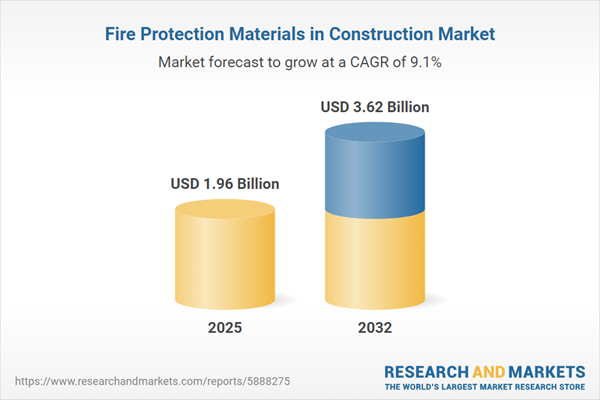Speak directly to the analyst to clarify any post sales queries you may have.
The Fire Protection Materials in Construction Market is evolving rapidly as technological innovation, shifting regulatory landscapes, and advanced product needs reshape how safety is achieved and maintained in commercial, industrial, and residential projects. Senior leaders face pivotal choices regarding supply chain resilience, strategic investments, and compliance with new standards.
Market Snapshot: Fire Protection Materials in Construction Market
The Fire Protection Materials in Construction Market, valued at USD 1.80 billion in 2024, is projected to reach USD 1.96 billion by 2025, with a forecasted CAGR of 9.08% that will drive revenues to USD 3.62 billion by 2032. This robust growth is fueled by increasing complexity in building design, stringent policy mandates, and escalating focus on sustainability. Demand intensifies across North America, Europe, Asia-Pacific, and emerging regions, reflecting the sector’s essential role in life safety and risk containment.
Scope & Segmentation
- Product Types: Fire dampers, fire doors and frames, fire-resistant glass (insulated and laminated types), fire-resistant gypsum boards, firestop sealants, intumescent coatings (solvent-based and water-based).
- Material Compositions: Cementitious, epoxy, intumescent latex, silicone.
- Application Methods: Brush applied, spray applied (air-assisted, airless), trowel applied.
- Applications: Electrical cable protection, HVAC system protection (duct board, duct wrap), structural steel (new construction and retrofit), wall and partition protection.
- End Uses: Commercial (offices, retail), industrial, infrastructure, residential.
- Distribution Channels: Offline retail, online retail (brand websites, e-commerce platforms).
- Regions: Americas (United States, Canada, Mexico, Brazil, Argentina, Chile, Colombia, Peru), Europe (United Kingdom, Germany, France, Russia, Italy, Spain, Netherlands, Sweden, Poland, Switzerland), Middle East (United Arab Emirates, Saudi Arabia, Qatar, Turkey, Israel), Africa (South Africa, Nigeria, Egypt, Kenya), Asia-Pacific (China, India, Japan, Australia, South Korea, Indonesia, Thailand, Malaysia, Singapore, Taiwan).
Key Takeaways for Senior Decision-Makers
- Technological innovation—particularly in sensor integration for real-time monitoring and nano-reinforcement of coatings—is transforming how materials are specified and maintained in new and existing structures.
- Increasing regulatory scrutiny demands verification of performance under complex scenarios, prompting closer collaboration between manufacturers and testing authorities to accelerate unified industry protocols.
- Supply chain resilience is now a priority, with leading suppliers establishing regional production hubs and digital traceability systems to improve product availability and compliance certainty.
- Holistic integration of sustainable chemistries is emerging as a key differentiator for stakeholders aiming to limit environmental impact while meeting advanced fire-resistance requirements.
- Industry consolidation is underway, as alliances and acquisitions strengthen global distribution networks and expand R&D capacity for rapid response to evolving project demands.
- Lifecycle support services, such as predictive maintenance enabled by data analytics, are increasingly valued by property owners and facility managers seeking long-term returns and reliable safety assurance.
Tariff Impact on Fire Protection Materials Supply Chains
Recent U.S. tariffs on imported components for fire-resistant glass and intumescent chemicals have disrupted established supply chains, raising costs and prompting manufacturers to accelerate domestic production initiatives. These shifts have required capital investments in local facilities and workforce reskilling, but ultimately increase sector resilience. Collaborative efforts between logistics, materials science, and code enforcement communities are reimagining value chains to support continuity and market stability.
Methodology & Data Sources
This report draws on a multi-source research approach, including interviews with executives, testing laboratory directors, code officials, and architects. Secondary analysis includes regulatory documents, technical datasheets, patents, and field case studies. Insights are validated by triangulation and independent peer review, ensuring all findings meet strict standards of technical accuracy and industry relevance.
Why This Report Matters
- Provides strategic clarity for senior leaders navigating emerging compliance, sustainability, and technology-driven procurement mandates.
- Enables targeted investments in innovation and site resilience by tracking evolving segment trends, competitive strategies, and regional market dynamics.
- Supports more informed and agile decision-making through actionable insights tailored for current and anticipated construction market risks.
Conclusion
Rapid advances in technology, regulatory frameworks, and supply chain strategies will shape the future of fire protection materials across global construction markets. Leaders who proactively invest in sustainability, digital innovation, and collaboration will enhance safety outcomes and secure long-term value creation amid a shifting landscape.
Additional Product Information:
- Purchase of this report includes 1 year online access with quarterly updates.
- This report can be updated on request. Please contact our Customer Experience team using the Ask a Question widget on our website.
Table of Contents
3. Executive Summary
4. Market Overview
7. Cumulative Impact of Artificial Intelligence 2025
Companies Mentioned
The companies profiled in this Fire Protection Materials in Construction market report include:- 3M Company
- Akzo Nobel N.V.
- BASF SE
- CIN, S.A.
- Contego International Inc.
- CSW Industrials, Inc.
- Den Braven Limited by Arkema Group
- Etex Group
- Fire Protection Coatings Ltd.
- Hilti Corporation
- Intumescent Systems Limited
- Isolatek International
- Morgan Advanced Materials plc
- No-Burn Inc.
- PPG Industries Inc.
- RPM International Inc.
- Saint-Gobain Advanced Ceramic Composites
- Sika Group
- Specified Technologies Inc.
- Supremex Equipments Ltd.
- SVT Group
- Tenmat LTD by Diamorph Group
- The Sherwin-Williams Company
- Unitech Limited
- USG Corporation
- W. R. Grace & Co.
- Walraven Group
Table Information
| Report Attribute | Details |
|---|---|
| No. of Pages | 183 |
| Published | November 2025 |
| Forecast Period | 2025 - 2032 |
| Estimated Market Value ( USD | $ 1.96 Billion |
| Forecasted Market Value ( USD | $ 3.62 Billion |
| Compound Annual Growth Rate | 9.0% |
| Regions Covered | Global |
| No. of Companies Mentioned | 28 |









